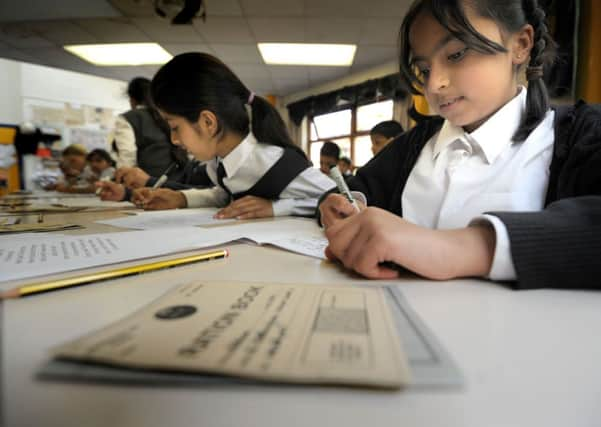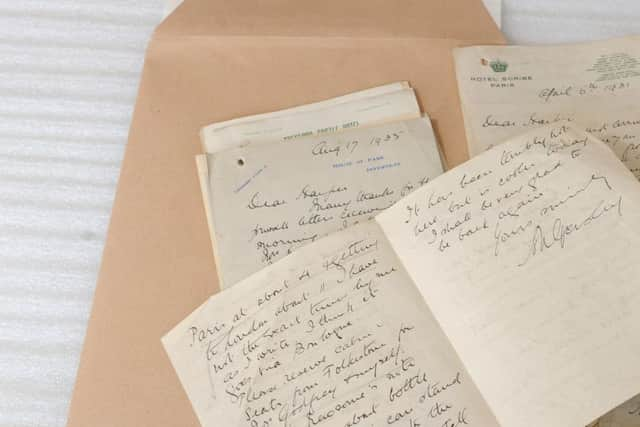Time for some joined-up thinking on future of handwriting – if it has one


ONCE a week, my elderly father – a copious letter writer – posts half a dozen entertaining bulletins in his increasingly arthritic scribble to family and friends around the globe.
On the back of the envelope there is always a one-line apology for the state of his handwriting. His was a generation that learned painstaking copperplate script, so having to lower standards in deference to the effects of age is highly frustrating.
Advertisement
Hide AdAdvertisement
Hide AdI keep all his letters, but do wonder what will happen to them if found by some descendant who is so unused to seeing old-fashioned cursive writing that they decide the letters may in fact be in a foreign language. Will they have to take these artefacts to a museum to be interpreted like Cuneiform?


I have offered now and then to type a letter for him, but this is met with a raised eyebrow and the look that says “Where’s the individuality in that? People love handwritten letters”. He is right - and I’m one of them.
But in a world where children are still generally taught joined-up writing at school, by and large we all see less and less handwriting. Around one in five children slip into texting language when they put pen to paper, according to a recent study. One in five parents said they’d last penned a letter more than a year ago.
In living our lives outside of school handwriting may seem to be becoming less relevant, but continuing to teach it is vital to general literacy, say the experts.
Advertisement
Hide AdAdvertisement
Hide AdAngela Webb is chair of the National Handwriting Association, whose stated aims are the promotion and understanding of handwriting, which it calls “the Cinderella of literacy”. The NHA is also a great source of information and support for children and parents looking for help with handwriting problems.
One recent study looked at the marks given for essays whose content was good but presented in poor handwriting and the same pieces of work submitted in neat and flowing script. The conclusion was that there was a reduction of 25 per cent in grade for those essays where the handwriting was not well-formed and easy to read.
“I don’t think of it as an art form,” says Angela. “That’s irrelevant. It’s a necessity, an important skill alongside reading, listening and speaking. Handwriting impacts on memory and the ability to absorb information.”
Educational thinking about handwriting has shifted back and forth, and in the 1970s it was a skill that suffered from little formal teaching. Yet in primary schools a high percentage of tasks still require it.
Advertisement
Hide AdAdvertisement
Hide Ad“If you had spoken to me 10 years ago, I would have been very concerned about this critical skill being lost but I think people realised not enough attention was being given to teaching writing and many schools now have a handwriting policy.
“And, let’s face it, most schools don’t have the money to give laptops or tablets out to all their children. I think keyboarding is likely to die out faster than handwriting, to be honest.”
However, Angela believes the child’s movements when forming letters needs to be monitored closely, so that bad habits don’t build up and hamper progress.
“It seems a lot of children are not necessarily always taught the most sensible way of making certain letters, and if that is happening then it means they are less able to go on to the flowing, cursive skill that moves at the same pace as their thoughts.”
Advertisement
Hide AdAdvertisement
Hide AdAccording to Rhona Stainthorp, a psychologist and professor of education at the University of Reading, although most schools have a handwriting policy and are good at getting children to grasp the basics of forming letters and words, the next stage – writing quickly – is often not included in the policy.
“(They) get children as far as joined up writing but after that lots of practice and exercises are needed to increase speed while maintaining enough legibility.
“Speed doesn’t automatically come to some children … they can need permission, if you like, to reduce the perfection of the appearance of their writing in order to reach sufficient speed to be ready for exams and to express themselves well.
“A very important point about being able to write fluidly and quickly is that it frees up mental energy to concentrate on content. Fast, legible handwriting shows the child is confident and in control.
Advertisement
Hide AdAdvertisement
Hide Ad“Appearance-wise, your writing just has to be legible enough for you to read it back yourself and for others to read it without difficulty. It doesn’t have to be perfect. Schools generally do a good job – they need to ensure a child can write at a decent speed with a variety of implements. My preferred implement is a 9mm pencil that has a soft rubber holder around the middle so you get a good grip.”
Advocates of the continuing importance of good handwriting are not Luddites about new technology. “I think it’s very good that we have exciting IT,” says Prof Stainthorp. “However we teach our children to use computers but not to touch type. In Australia all children are taught to type properly, rather than the ‘hunt and peck’ technique which, again, gets in the way of speed and fluency.”
Parent, teacher and writer Francis Gilbert agrees. “I believe that children should be taught to type properly, and they’re usually not.” But he also thinks handwriting should be emphasised more.
“Learning how to use a fountain pen properly, and how to write in italic script would help (children) to take more pride in what they do write. My literary hero is William Blake, who printed his books using his own handwriting, which he actually wrote backwards onto metal plates using a type of varnish.
Advertisement
Hide AdAdvertisement
Hide Ad“The experience of reading his illuminated books in which you can see his actual handwriting, is one of the most rewarding things for any English Literature student to do.
“However, I do believe that students have a bad experience of handwriting because they often use it in exams in very high pressure situations, thereby associating handwriting with misery and panic. I think we need to foster a new spirit of creativity and pride where handwriting is concerned.
Gill Chadwick, mother of 15-year-old Tom, is grateful that IT means he is not at the mercy of his handwriting – which, due to having the developmental condition dypraxia, is roughly that of a five-year-old.
“I think the value of handwriting is overrated,” says Gill, who’s from Leeds. “Tom is really bright and has just done brilliantly at a GCSE physics paper, but make him do a handwriting task and he goes to pieces because he knows his writing is infantile.
Advertisement
Hide AdAdvertisement
Hide Ad“Dyspraxia affects motor skills like handwriting or drawing, so when he has to concentrate on making the shapes of the words the content is lost, as he can’t focus on both.
“Luckily his school is brilliant and (mostly) very switched on about it, so he can do most of his lessons and homework on the computer. When it comes to big exams he will be allowed to use a computer and get a bit of extra time. But his history teacher still shouts about the untidiness of his exercise book.
“In the grown-up world he’ll never have to use handwriting again. The problem is getting him through the next few years.”
Meanwhile some experts disagree on the value of learning joined up or cursive writing in the modern world, when thy say the time could be better spent on improving IT skills. In Indiana in the US formal teaching of cursive writing has been dropped, whereas in North Carolina a Bill was passed recently to ensure that its teaching remains obligatory.
Advertisement
Hide AdAdvertisement
Hide AdIt’s a sad thought that in some places handwriting may only be seen in the future on a shopping list – if at all.
What to look for – at any age
Find out what ‘normal’ handwriting for a child of their age is like by looking at the work of other children.
Watch how they write as well as what they produce.
Look at general co-ordination with other implements, like a knife and fork. This will give an indication if immature or impaired co-ordination might be contributing to any difficulties.
Make sure when writing at home they are sitting at a table on a chair of the right height, and not lying on the floor, in front of the TV.
Source: The National Handwriting Association – www. nha-handwriting.org.uk